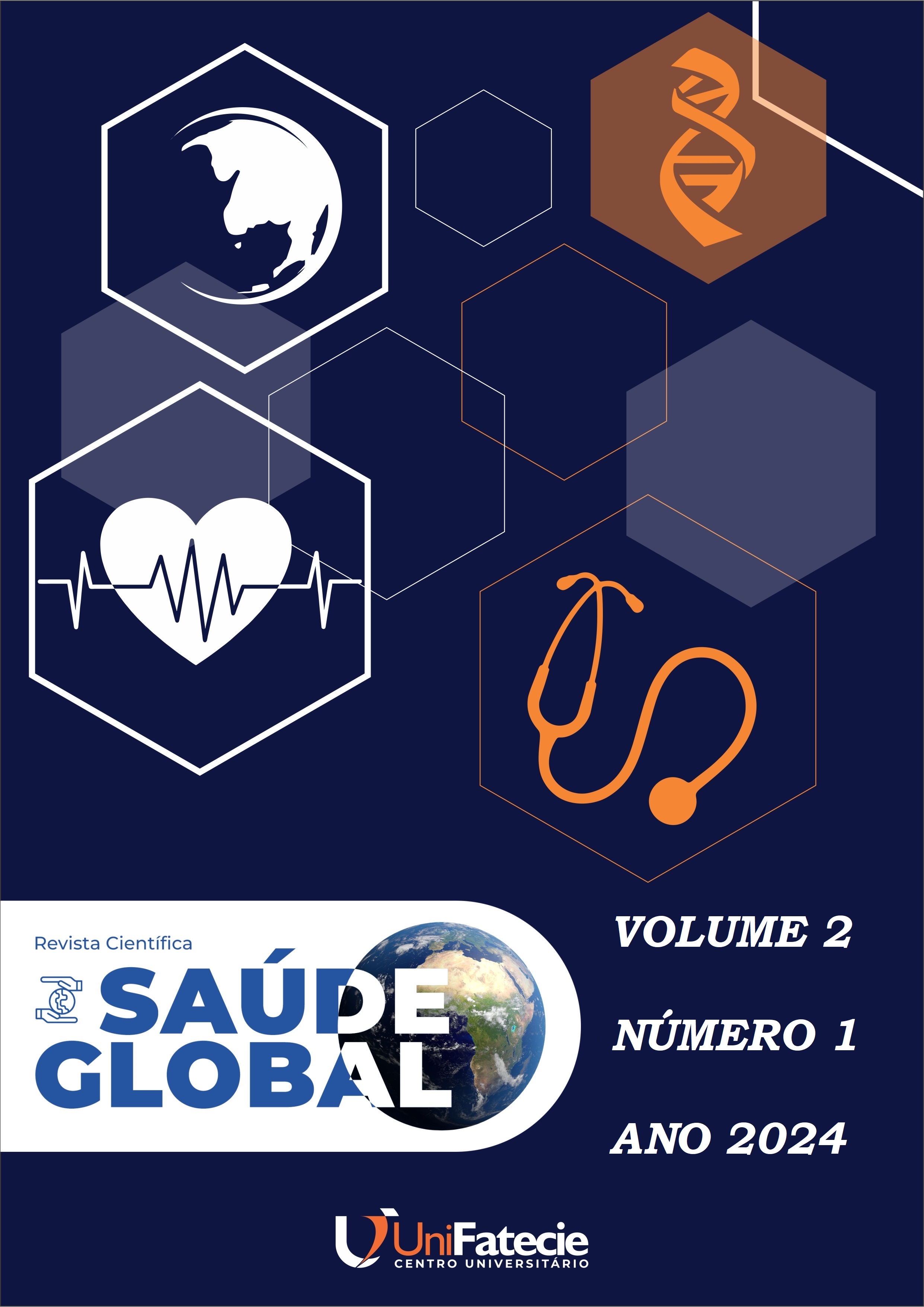Câncer do colo do útero e biomarcadores
uma revisão de literatura
DOI:
https://doi.org/10.33872/saudeglobal.v1n2.e014Palavras-chave:
Células cancerígenas, Biomarcadores, CâncerResumo
Objetivo: Apresentar uma Revisão bibliográfica sobre células cancerígenas, câncer do colo do útero e os principais biomarcadores de diagnósticos do câncer do colo do útero. Métodos: selecionar artigos em diferentes bases de dados últimos dez anos. Resultados: O câncer do colo do útero é um dos tipos mais comuns de carcinoma no mundo e suas principais causa são causadas pela infecção do HPV em células humanas. Conclusão: Destacar a prevalência e o aumento progressivo do câncer do colo do útero como um dos fatores causados pela infecção pelo HPV e seus respectivos biomarcadores de diagnósticos, relevantes para a detecção do câncer de colo do útero.
Referências
Babichenko, I.I.; Kovyazin, V.A. New Methods of Immunohistochemical Diagnostics of Tumor Growth. M: RUDN. 2008. Available online: https://sci.house/onkologiya/novye-metody-immunogistohimicheskoy.html (Acessado em 21 de Out de 2024).
Balasubramaniam, S.D, et al. Key molecular events in cervical cancer development. Medicina (Kaunas), 2019; 55, 384. doi:10.3390/medicina55070384.
Bermudez, et al. Cancer of the cervix uteri. International Journal of Gynecology & Obstetrics. 2015, 131, S88-S95. doi: 10.1016/j.ijgo.2015.06.004.
Chaffer, C.L; Weinberg, R.A. A perspective on cancer cell metastasis. Science, 2011; 331:1559–64. doi: 10.1126/science.1203543
Da Costa, L.B.E, et al. p16INK4a, Cytokeratin 7, and Ki-67 as potential markers for low-grade cervical intraepithelial neoplasia progression. Journal of Lower Genital Tract Disease. 2017, 21, 171–176. doi: 10.1097/LGT.0000000000000310.
Fitzmaurice, C, et al. Global, Regional, and National Cancer Incidence, Mortality, Years of Life Lost, Years Lived With Disability, and Disability-Adjusted Life-Years for 29 Cancer Groups, 1990 to 2017 A Systematic Analysis for the Global Burden of Disease Study. JAMA Oncol. 2019;5(12):1749-1768. doi:10.1001/jamaoncol.2019.2996
Hulka, B. S. Epidemiological studies using biological markers: issues for epidemiologists. Cancer Epidemiology, Biomarkers e Prevention. 1991, 1, 13.
Hunsberger, H. C, et al. Divergence in the metabolome between natural aging and Alzheimer’s disease. Scientific Reports. 2020, 10, 12171. doi: 10.1038/s41598.020-68739-z
INCA, Instituto Nacional do Câncer. https://www.gov.br/inca/pt-br/assuntos/gestor-e-profissional-de-saude/controle-do-cancer-do-colo-do-utero/dados-e-numeros/incidencia. Acesso em 02 de Ago de 2024.
Li, B, et al. Expression of E-, P- and N-cadherin and Its clinical significance in cervical squamous cell carcinoma and precancerous lesions. PLoS ONE, 2016, 11, e0155910. doi: 10.1371/journal.pone.0155910.
Martin, C.M, et al. Histology of cervical intraepithelial neoplasia and the role of biomarkers. Best Practice & Research Clinical Obstetrics and Gynaecology, 2011, 25, 605-615. doi:10.1016/j.bpobgyn.2011.04.005.
Murali, R, et al. The roles of pathology in targeted therapy of women with gynecologic cancers. Gynecologic Oncology. 2018, 148, 213–221. doi: 10.1016/j.ygyno.2017.11.020
Nakamura, M, et al. The Association and significance of p53 in gynecologic cancers: The potential of targeted therapy. International Journal of Molecular Sciences, 2019, 20, 5482. doi: 10.3390/ijms20215482.
Nenclares, P.; Harrington, K.J. The biology of cancer. Medicine (United Kingdom) 2020, 48:2,67-72. doi:10.1016/j. mpmed.2019.11.001.
Oyouni, A.A.A. Human papillomavirus in cancer: Infection, disease transmission, and progress in vacines. Journal of Infection and Public Health, 2023; 16:626–631. doi: 10.1016/j.jiph.2023.02.014.
Ozbun, M.A; Campos, S.K. The long and winding road: Human papillomavirus entry and subcellular trafficking. Current Opinion in Virology, 2021; 50: 76–86. doi: 10.1016/j.coviro.2021.07.010.
Korolenkova, L.I. Cervical intraepithelial neoplasms and early forms of cervical cancer: clinical and morphological concept of cervical carcinogenesis, 2017; ISBN 978-5-903759-28-6. Available online: http://www.medlib.kuzdrav.ru/articles/26/4361
Rogovskaya, S.I. Human papillomavirus infection of the genitals. In Cervix, Vagina, Vulva. Physiology, Pathology, Colposcopy, Esthetic Correction: A Guide for Practicing Physicians, 2nd ed.; Rogovskaya, S.I., Lipova, E.V., Eds.; M: Status Praesens; Journal Publishing House Status Praesens: Moscow, Russian, 2016; pp. 305–378.
Salazar-Roa, M.; Malumbres M. Fueling the cell di¬vision cycle. Trends Cell Biology, 2017; 27:1,1–92. doi:10.1016/j. tcb.2016.08.009.
Timoshenko, O.S, et al. Tissue colagenase MMP-14 and endogenous regulators of its activity in the corpus uteri in squamous cell carcinoma of the cervix. Arkhiv Patologii. 2017, 79, 36–42. doi: 10.17116/patol201779636-42.
Tong, R. et al. OVCA1 expression and its correlation with the expression levels of cyclin D1 and p16 in cervical cancer and intraepithelial neoplasia. Oncology Letters. 2017, 13, 2929–2936. doi: 10.3892/ol.2017.5848.
Volkova, L.V, et al. Cervical Carcinoma: Oncobiology and Biomarkers. International Journal of Molecular Sciences. 2021, 22, 12571. doi: 10.3390/ijms222212571
Wang, R.A, et al. Invasive cancers are not necessarily from preformed in situ tumours - an alternative way of carcinogenesis from misplaced stem cells. Journal of Cellular and Molecular Medicine 2013; 17:921-6. doi:10.1111/ jcmm.12078.
Weitzman, M.D, et al. Cell cycle: DNA damage checkpoints. Encyclopedia of Biological chem¬istry III, 3 Ed. Elsevier, 2021, 2(9).
Yang, N.; Sheridan, A.M. Cell Cycle. Encyclopedia Toxicology (Third Ed), 2014. doi:10.1016/B978-0-12-386454-3.00273-6.
Yeo-Teh, N.S.L, et al. Human papillomaviral oncogenes e6 and e7 target key cellular pathways to achieve oncogenesis. International Journal of Molecular Sciences, 2018; 19, 1706. doi: 10.3390/ijms19061706.
Zamora-Obando, H.R, et al. Biomarcadores moleculares de doenças humanas: conceitos fundamentais, modelos de estudo e aplicações clínicas. Química. Nova, 2022; 45, 9, 1098-1113. doi: 10.21577/0100-4042.20170905.








